The AMD Radeon R9 290 Review
by Ryan Smith on November 5, 2013 12:01 AM EST- Posted in
- GPUs
- AMD
- Radeon
- Hawaii
- Radeon 200
Compute
Jumping into pure compute performance, this is another scenario where the 290X shouldn’t throttle as much, and as such the performance differences between the 290 and 290X should be closer to what they are on paper. With compute workloads the ROPs aren’t being hit hard, so that’s power and thermal savings that lets both cards operate at close to their maximum boost clocks.
As always we'll start with our DirectCompute game example, Civilization V, which uses DirectCompute to decompress textures on the fly. Civ V includes a sub-benchmark that exclusively tests the speed of their texture decompression algorithm by repeatedly decompressing the textures required for one of the game’s leader scenes. While DirectCompute is used in many games, this is one of the only games with a benchmark that can isolate the use of DirectCompute and its resulting performance.
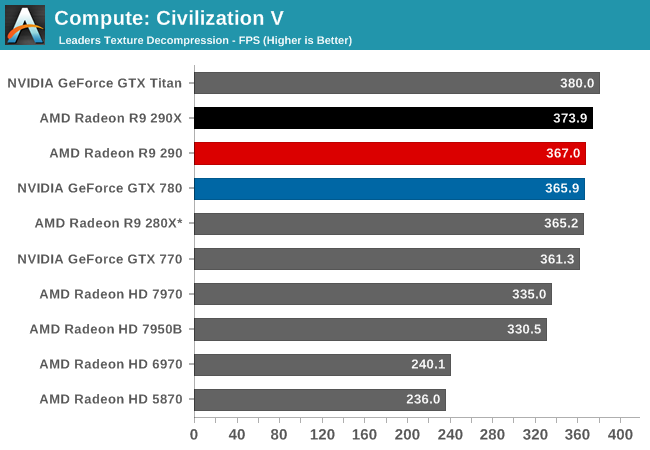
As with the 290X, Civ V can’t tell us much of value due to the fact that we’re running into CPU bottlenecks, not to mention increasingly absurd frame rates. The 290 is marginally slower than the 290X due to the lower clockspeeds and missing CUs, but minimally so.
Our next benchmark is LuxMark2.0, the official benchmark of SmallLuxGPU 2.0. SmallLuxGPU is an OpenCL accelerated ray tracer that is part of the larger LuxRender suite. Ray tracing has become a stronghold for GPUs in recent years as ray tracing maps well to GPU pipelines, allowing artists to render scenes much more quickly than with CPUs alone.
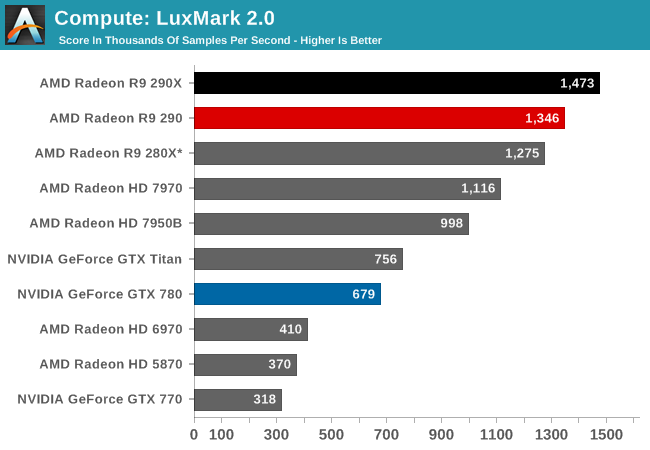
With both cards unthrottled and bound solely by shader performance, it’s an outright foot race for the Radeon cards. 290 trails 290X by around 9%, closely mirroring the difference in the CU count between the two cards. Though 290 is being very closely chased by the 280X, as Hawaii in general seems to have trouble getting the most out of its shader hardware on this benchmark.
Our 3rd compute benchmark is Sony Vegas Pro 12, an OpenGL and OpenCL video editing and authoring package. Vegas can use GPUs in a few different ways, the primary uses being to accelerate the video effects and compositing process itself, and in the video encoding step. With video encoding being increasingly offloaded to dedicated DSPs these days we’re focusing on the editing and compositing process, rendering to a low CPU overhead format (XDCAM EX). This specific test comes from Sony, and measures how long it takes to render a video.
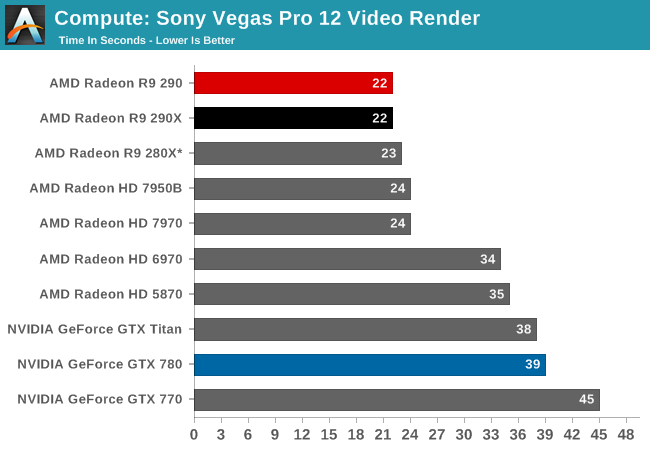
There’s not enough of a GPU performance difference between the two cards to matter with this test. Both tie at 22 seconds.
Our 4th benchmark set comes from CLBenchmark 1.1. CLBenchmark contains a number of subtests; we’re focusing on the most practical of them, the computer vision test and the fluid simulation test. The former being a useful proxy for computer imaging tasks where systems are required to parse images and identify features (e.g. humans), while fluid simulations are common in professional graphics work and games alike.
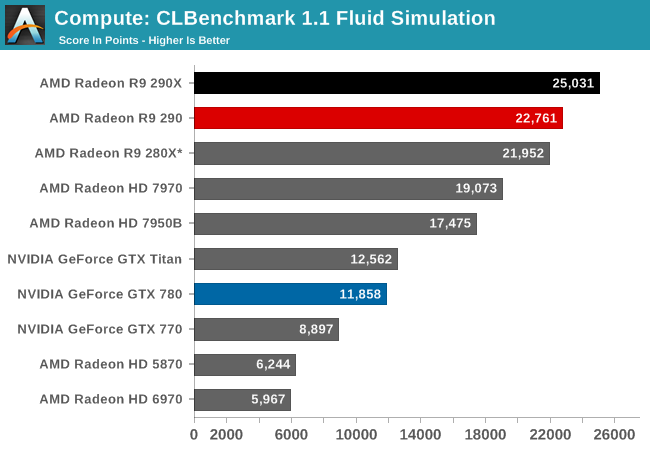

In the CLBenchmark fluid simulation the 290X and 290 take the top spots as expected, with the 290 trailing once more by 9%. However both Hawaii cards are still struggling with the computer vision benchmark, leading to the 290 being edged out by the 7970 of all things.
Moving on, our 5th compute benchmark is FAHBench, the official Folding @ Home benchmark. Folding @ Home is the popular Stanford-backed research and distributed computing initiative that has work distributed to millions of volunteer computers over the internet, each of which is responsible for a tiny slice of a protein folding simulation. FAHBench can test both single precision and double precision floating point performance, with single precision being the most useful metric for most consumer cards due to their low double precision performance. Each precision has two modes, explicit and implicit, the difference being whether water atoms are included in the simulation, which adds quite a bit of work and overhead. This is another OpenCL test, as Folding @ Home has moved exclusively to OpenCL this year with FAHCore 17.
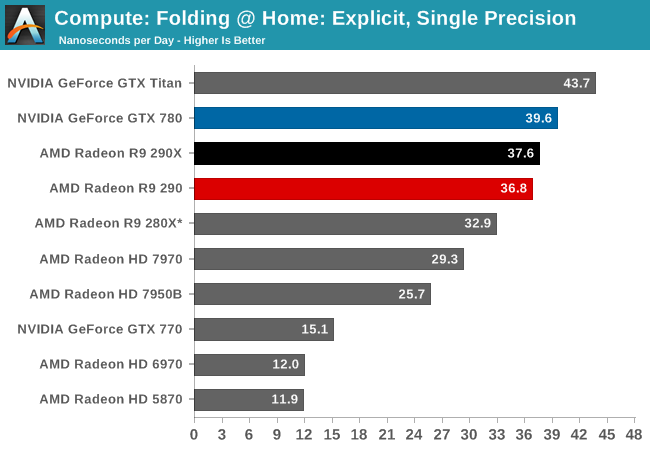
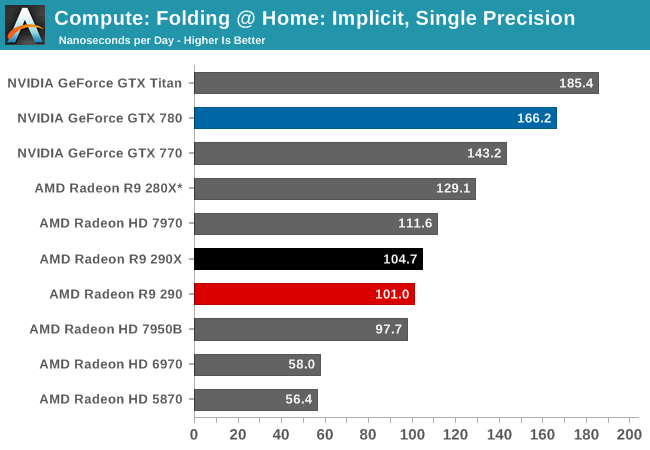
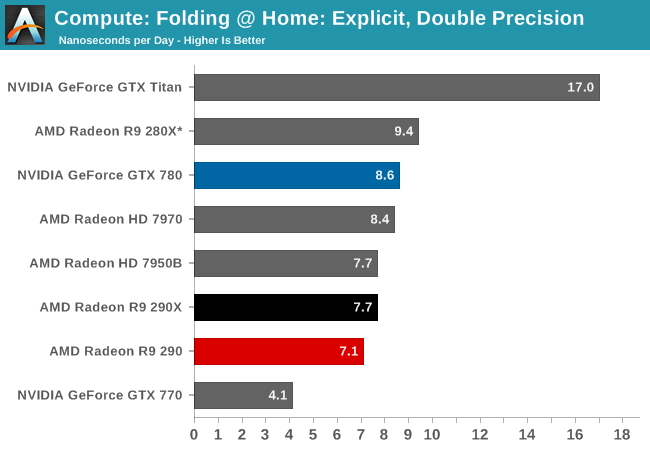
Generally Tahiti and Hawaii are strong performers in the GPU compute arena, but that isn’t of particular help to the 290 here, as it loses out to the GTX 780 in every mode. In single precision FAHBench has trouble putting Hawaii to good use at times, while double precision tests have the 1/8th DP rate 290 and 290X falling behind due to their lower than Tahiti DP throughput.
Wrapping things up, our final compute benchmark is an in-house project developed by our very own Dr. Ian Cutress. SystemCompute is our first C++ AMP benchmark, utilizing Microsoft’s simple C++ extensions to allow the easy use of GPU computing in C++ programs. SystemCompute in turn is a collection of benchmarks for several different fundamental compute algorithms, as described in this previous article, with the final score represented in points. DirectCompute is the compute backend for C++ AMP on Windows, so this forms our other DirectCompute test.
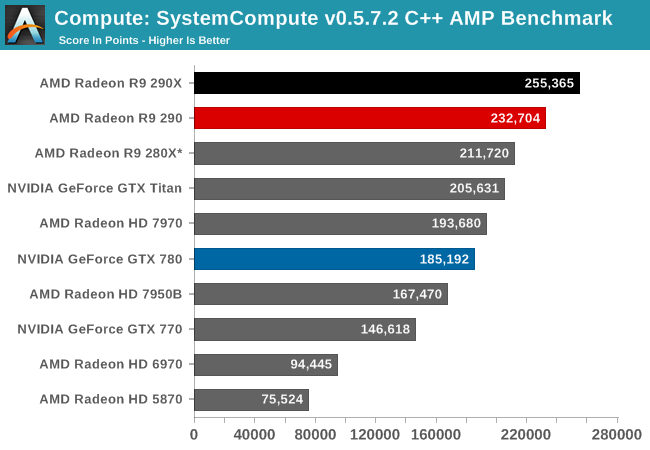
SystemCompute is another benchmark where 290 and 290X do not experience meaningful throttling, and as such are separated by more than what happens in our gaming benchmarks. In this case 290 yet again trails 290X by 9%, though it still enjoys a considerable lead over the GTX 780 and all other NVIDIA cards.










295 Comments
View All Comments
Leyawiin - Tuesday, November 5, 2013 - link
I'd just wait for the ASUS DirectCU II version or something equivalent. Something as hot, loud and power hungry as the old GTX 480 isn't acceptable to me, but drop a couple of those cons and I'd be on board.FuriousPop - Tuesday, November 5, 2013 - link
No... But..........the.......................noise...................is........... just............too........ loud.......... are....you......getting..............this.......*puts on headphones*
Now then, as i was saying its very loud but but i want it whisper quiet, so buzz off else where then. your 2cents here is not appreciated.
as a CFx7970 owner (not to mention i had 2xgtx670's just before that which 1 became DOA and yes just as loud as current GPU's) i can safely say - noise is NOT a reason to be placing the whole argument onto when deciding about price/performance wise when there are sooo many different things you can do to reduce the noise generated from your case - if your unwilling to then obviously logic dictates that you would NOT purchase this, clearly.... but but i still wanna compare my 6 month old GPU to this one....... of course you can junior.... of course you can...
Custom coolers will come and will reduce the temps/noise, maybe not by a massive amount, but maybe just enough to convert some of those green boys over!
stangflyer - Tuesday, November 5, 2013 - link
I am a older gamer at almost 50. I have had many cards since my first 3DFx card. Both AMD/ATI and Nvidia have been in my cases. I have a 1440p monitor but also game at 5040x1050 eyefinity.Currently run 2x7950 sapphire flex boost cards. They run relatively quiet as I have a empty slot in-between the cards.
I listened to some of the sound clips of the 290/x and they reminded me of my 5970 that I ran before my 7950's. I swore I will never have anything that loud in my pc again.
Will wait and see what the custom coolers bring to the table as I am hoping to go to one card even though I know I will lose some performance. Or just wait for 20nm.
I was over at my cousins and he showed me his new 780gtx with the acx cooler. Mild OC and it was extremely quiet.
I will play with either red or green cards but I do know that I will pay 100 bucks for the noise diff of the 780gtx.
We will see.
lnanek - Tuesday, November 5, 2013 - link
Hmm, loud cards are good for me, I always use earbuds anyway.Sancus - Wednesday, November 6, 2013 - link
Everyone who says "just use headphones" probably doesn't realize that these AMD cards are so loud that they would actually be quite disturbing to anyone else in the room, and in the case of Crossfire, probably your entire house or adjacent apartments. 2x 290X's in CF Uber mode are approaching vacuum cleaner levels of noise.Not recommending these cards due to noise is not 'biased' it's merely a common sense, practically based choice.
ClexRex - Wednesday, November 6, 2013 - link
Agrred ive played with the 290x and unless you keep your pc in the other room defiantly hold out till the aftermarket cool is here otherwise youll be pissed and havto spend another 50 on aftermarket cooling once available.Also a lot of people hatng on the 780 forget one thing..that it overclocks better than the 290/290x flat out...it also have the option for custom bios which in return will boost the 780 above the 290 and do it at a lower power comsumption/noise/heat
Also to crossfire the 290 you will need a min. of 1000w psu as we ran intoissues with 800w psu's during testing with crossfire and heavily overclocked cpu's.
rtho782 - Wednesday, November 6, 2013 - link
This card actually hits louder noise levels than the old FX5800 Ultra! http://techreport.com/review/4966/nvidia-geforce-f... Not exactly the same method to measuring but this was 10 years ago...AnnihilatorX - Wednesday, November 6, 2013 - link
The above statement I feel is an over-simplication.
I would imagine the actual instantaneous clock-for-clock power consumption will actually decrease due to the lower computation units. However, R290 or R290X cannot sustain their boost clock and are nearly always throttled by their thermal limits. Hence, the practical power consumption is similar, and since at the same power output R290 would have to have a higher clock to match the speed to R290X, the theoretical efficiency is somewhat lower, but I don't think they differ by much.
UGMan - Wednesday, November 6, 2013 - link
Come on AMD, get this beauty out with coolers from ASUS, MSI, Sapphire et. al. and then TAKE MY MONEY ! Please !!!Nothing out there touches it for the price, and AMD have finally sorted out crossfire. I've got a feeling that Mantle is going to shock and awe with it's performance.
Bring it on !!!
Vorl - Wednesday, November 6, 2013 - link
for everyone using stupid sound comparisons, like "a 747 taking off". Here are some real comparisons.Whisper Quiet Library at 6' 30dB
Normal conversation at 3' 60-65dB
Telephone dial tone 80dB
http://www.gcaudio.com/resources/howtos/loudness.h...
I think that the reviewer is biased considering how big a deal they make of noise now, but in the past with noisy nvidia cards it was more like "meh, they are noisy, BUT FAST". Now they are all over "how loud the card is".